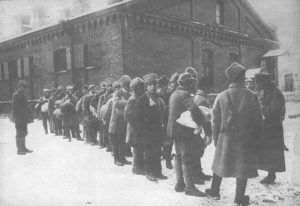Dispossessed Peasants in Prison, 1918
https://russiainphoto.ru/
By Adam Rodger
The Havighurst Center hosted Dr. Anne O’Donnell, a historian who studies the transformation of state institutions throughout the Russian Revolution, on 10 October 2016. Dr. O’Donnell gave a lecture on the shifting attitudes toward property in the early Soviet Union, and its connection to the ideology of the revolution. She discussed what she termed the “whirlwind of dispossession,” wherein property was confiscated from countless people, and argued that this haphazardly-executed policy of seizure was intended as a means of rebuilding the population into proper “Soviet” citizens. The lecture was attended by the Havighurst Colloquium, as well as Havighurst Center faculty and various other students.
In what Dr. O’Donnell calls the “Morning After” the revolution, a phrase that refers to the confusion experienced by citizens immediately after a revolution such as the October 1917 seizure of power by the Bolshevik Party in Russia. Her lecture focused on the story of one “citizeness Tikhobrazova,” a woman from Petrograd who was forced to flee to southern Russia with her son during the civil war, leaving all of her property in a warehouse. When she returned, she discovered that all the property had been confiscated and, as far as the law was concerned, no longer belonged to her. She petitioned several state institutions, including the court, but even those that ruled in her favor were either unwilling or unable to deliver to Tikhobrazova her things. In the end, while she “managed to beg a sympathetic employee for her photo album,” the record shows no sign that she ever regained anything else.
O’Donnell used this story to illustrate several points about the nature of life after the revolution. One of these was the way in which Soviet ideas on property influenced the lives of citizens. “The seizure of goods,” O’Donnell argued, “is a step toward dehumanizing a population.” The dehumanization, however, was not the goal of dispossession in the Soviet case. Instead, the goal was the reforging of Russian people into real “Soviet” citizens, and part of this transformation required a change in how the people understood property. When Tikhobrazova was refused her things, such as a table, chairs, and other personal property, the warehouse management and the so-called troika agreed that she should not be sent away empty-handed; they decided she would receive a table, chairs, and other goods, but they would not be her originals. She was allowed “all that was necessary for two people according to the norm from the general fund.” In O’Donnell’s words, it was a way “to restore objects in a way that does not legitimize possession.” This was the new understanding of property; nothing in the Soviet house belonged to those who lived there, but instead it belonged to the state.
The dispossession suffered by Tikhobrazova was not unique; O’Donnell suggested that most Soviet citizens had similar experiences. Possessions were taken without justification, sometimes by bandits, sometimes by state organizations like the Cheka (the first Soviet secret police), and sometimes it was unclear who the dispossessors were. This was not even restricted to the bottom levels of Soviet society; a few people were able to avoid significant dispossession (O’Donnell mentioned that Lenin’s dentist was among those spared), but the experience of dispossession was so widespread, and so close to the revolution, that to some extent it became a part of the revolutionary experience. People who had not had the experience of dispossession were more easily characterized as class enemies, because they had not “suffered for the revolution.”
Another point illustrated by Tikhobrazova’s story refers to the “institutional cacophony” evident in Soviet bureaucracy. The abundance of overlapping state administrative agencies led to intense confusion over jurisdiction, and, therefore, over authority. In the case of Tikhobrazova, even an agent of the court was incapable of convincing the warehouse management to relinquish her property. This level of disarray was a common theme throughout the lifetime of the Soviet Union, to one degree or another, but it was particularly chaotic in the “Morning After” the revolution.
Adam Rodger is a second-year M.A. student in History at Miami.


1 Response to A Whirlwind of Dispossession in the Morning After the Russian Revolution